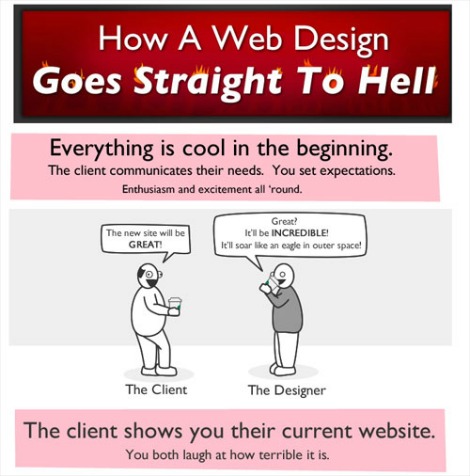
So, your client “made you do that”? A post for designers, by a designer
Have you ever had a situation where you worked on a great design, and the client asked you to change it to be more what THEY thought looked good – but you didn’t like their suggestions?
Have you ever been commissioned to create a website, and you show the initial concepts to the client, they ask you to make some changes – (make it blurry, or centre the text, or make the logo bigger, change an image) – but it just makes the design look BAD? It may be they are quite strong willed clients (more dominant than you are perhaps) – and you may protest but end up backing down to please them.
This probably happens a lot. You start the design process with the optimistic attitude of “of course I can design a better website than the one they have now!” – and this is probably true. But you didn’t account for is the client’s taste and opinion.
This was beautifully illustrated in this article by Matthew Inman in his famous comic “How a Web Design Goes Straight to Hell” written on The Oatmeal. Have a look – it really says it all!
theoatmeal.com/comics/design_hell
Although we aren’t going to point out any specific examples (too embarrassing!), we have to admit – it’s happened to us. Not often, not too recently, but it has. Has it happened to you?
A matter of taste
There is a reason why so many bad websites end up in the public domain, representing (or rather mis-representing) real businesses and organisations. These websites are – in one word – embarrassing. Or, in more words – they are horrendous abominations which should be removed from the public domain before anyone sees them.
But the owners of the website don’t think so. They often like – or even LOVE – their websites! It is a product of their direction, research, content and opinion.
If you saw a website which you thought was really poorly designed, you would blame the designer – and you would be shocked they would even take money from the poor client. And often, they are to blame. Luckily, 99% of the time we are able to steer the client to get to a result which everyone is happy with, and we are proud to show on our portfolio.
But sometimes things don’t quite go as planned.
Here are 3 typical scenarios.
- The client asks us to make changes to the design (or asks us to use images) which we don’t think will look very good. We show them the options (or images) they want, but we also suggest alternatives, mocking up better looking versions. However, they choose the option which they wanted, despite our best efforts to sway them to the side of the more beautifully designed options.
- The client asks us to design the website but it is built by a 3rd party developer who the client has chosen, and the end result looks nothing like our design
- The website goes live looking fantastic, but the client updates the website themselves, often with a CMS, and doesn’t pay attention when images are distorted, capitalisation is inconsistent, and text formatting was amateur.
What can you do?
Our reaction has always been to tell the client, as tactfully as we can, that we don’t like the way the design has developed, or the way the site has evolved. After all – we are the experts! There is a great article about this on Smashing Mag (an oldie but still relevant) – How to Explain to Clients They Are Wrong. It gives good tips but you cant predict a client’s reaction.
But sometimes, especially in the design phase, this can cause a client to assert themselves, to the extent that they may even complain or threaten to pull the project. It has to be done tactfully and carefully.
What then? You don’t want to upset the client, as they may complain about you and say you are overly bossy or you don’t listen to them.
But then, on the other hand, you wouldn’t want the client telling anyone you did the work – as you aren’t proud of it.
Has anyone ever decided to drop the project – and “fire the client” when this has happened?
Or have you just in the end, backed down and launched the site, and tried to forget it ever happened and hidden it from your portfolio?
I would love to hear all your comments and experiences. Don’t be shy, come out and tell us what happened to you!


